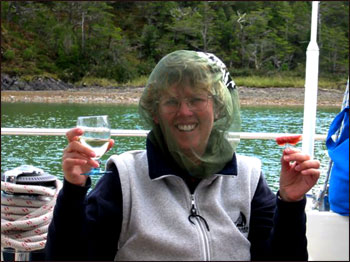 What advice would you give women in setting up their galleys, in preparing to cook aboard? What advice would you give women in setting up their galleys, in preparing to cook aboard?
There is nothing worse than opening a galley cupboard door and having the entire contents spew out on top of you and beyond!! To avoid such a catastrophe you need to plan your galley to be easy to use when passage making.
Start by determining which items you use most frequently, and store them so they are easily accessible. This will probably include mugs, bowls, plates, pots and pans. I have these items stored in an aft facing cupboard, which is less likely to empty out. Hot drinks are high on my captain's consumption list! We have an open shelf system which holds five plastic airtight containers with coffee, tea, sugar, etc. to make hot drink preparation easy.
Planning and organization make cooking aboard a cinch! Make a rough menu plan to help you prepare your shopping list (you will be at sea for X number of days, so will need at least X lunches, suppers etc). You also need to determine your normal consumption level of food items (how many days a box of cereal will last you) and determine if this consumption pattern will be the same when you are on your boat (I drink fewer hot drinks when we are passage making).
Luckily we have a number of lockers in the saloon so that I can store like things together:
1) for tinned meats, fish, vegetables, etc
2) tinned fruits and packaged baking goods
3) condiments, mayonnaise, etc
4) rice, crackers and cookies |
|
5) cereals and snacks
6) UHT milk and juice
7) wine
8) beer and soft drinks |
I have a small note book with a page for each locker and I list the food items and quantity.
I use a pencil so I can change the numbers when an item is used.
This saves hunting through your lockers every time you need to shop.
 |
No flies will bother me in Patagonia |
Today you can just about get anything you want anywhere in the world. In the 1980's heading into the Pacific we planned for 6 months as we would have to be our own supermarket!! Besides all the usual things, I had 10 large jars of mayonnaise (knowing New Zealand did not have it that time); real mayonnaise can now be found everywhere.
However, there are still circumstances when you have to buy stores to last you for a number of months, such as for our trip through Patagonia where there are no stores for stocking up.
|